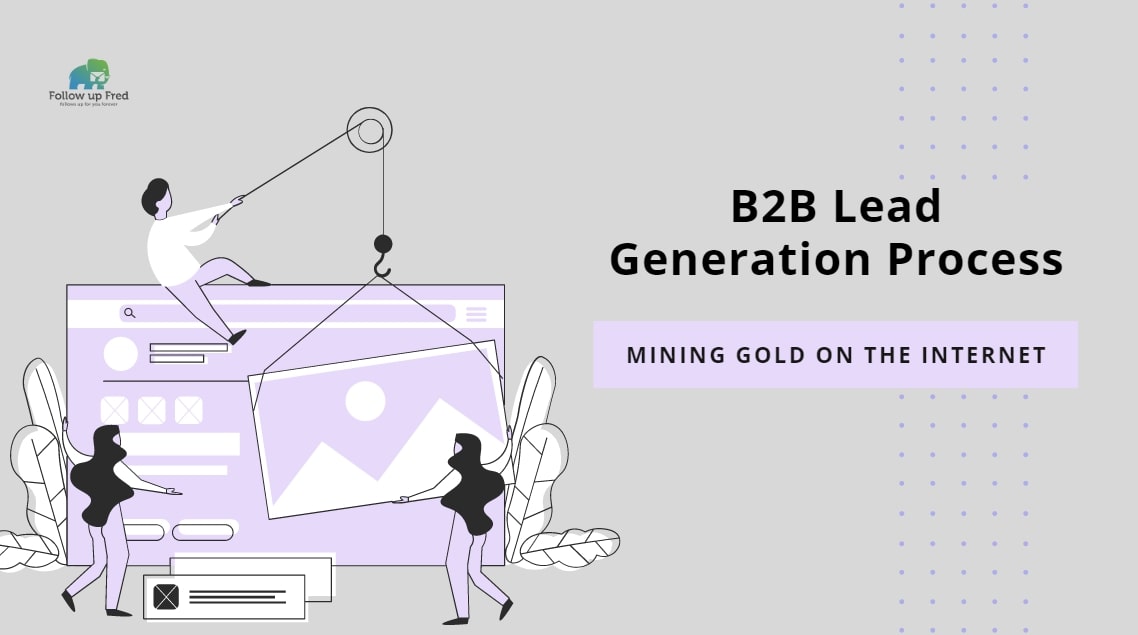B2B leads: Mining gold on the internet
For many businesses, B2B lead generation is like panning for gold; it’s hard to find, there doesn’t seem to be any rhyme or reason, and while some organizations seem to have wild success, it seems impossible to tell how they’re doing it. Thing is, generating solid B2B leads isn’t about luck, or some arcane alchemical process that mere mortals can’t understand. The lead generation process can be optimized and perfected using the proper tools and tactics. Let’s show you how to generate B2B leads and how to create a lead nurturing campaign that will produce repeatable, workable, and enviable results!

Solid Leads And You
A lead isn’t just some random potential client. A solid lead is one that has a problem your product or service can solve, one that’s only a step or two away from becoming your client. Generating a lead and converting them to a client is about getting their attention, demonstrating and providing value, and showing that your solution can solve their problem.
In B2B marketing, generating quality leads is one of the most important if not the most important job we do. We can’t afford to treat lead marketing like panning for gold, aimlessly wandering around ankle-deep in cold water hoping for a big score. Achieving success is about creating and implementing a proven and repeatable lead generation process.
What is lead generation process? A process-driven strategy that establishes a consistent pipeline of solid leads. Whether you focus on outbound or inbound, whether you’re building a killer funnel or a clever social media strategy, that pipeline is the end goal. Most successful B2B lead generation uses a mix of different tactics to keep the pipeline moving; even the best marketing teams swing and miss on occasion and having multiple channels and tactics ensures that a bad week on one front is compensated for by success elsewhere.
After all, understanding how to qualify leads is a key next step in the lead generation process. As you’ve built a pipeline and leads start coming in, it’s crucial to figure out which ones are worth pursuing. Qualifying leads means checking if they’re a good fit for your product or service by looking at factors like their budget, decision-making power, needs, and buying timeline. This helps businesses focus their time and energy on leads that are more likely to turn into paying customers, ensuring that both marketing and sales teams are working together efficiently toward shared goals, and making the most out of every opportunity. Simple, yet strategic, this step is all about making sure efforts are placed where they’ll count the most.
Outward Bound
When we talk about outbound marketing, this includes most of the ‘classic’ marketing methods. TV and radio advertising, cold calls, flyers, billboards, search ads, trade shows, etc. These methods tend to get a bad rap these days; people don’t want to be sold to, they don’t want to be bombarded by ads. People don’t want stuff pushed at them. All the ‘hip’ methods of marketing today involve inbound marketing (we’ll get to that in a second) so there’s a bit of a bias against outbound tactics.
However, when it comes to generating sales leads, marketing tactics shouldn’t be judged based on how cool they are, they should be judged on one metric: do they work? And sometimes outbound marketing can be a very effective part of your strategy.
Take, for example, cold emails. Now, the conventional wisdom is that cold emails don’t get read, right? We all receive a million emails per day that go straight to the spam folder. However, conventional wisdom isn’t necessarily right. If you’re smart about it, do your research, locate your target and strike with precision, cold emails can be highly effective.
You’re going for quality, not quantity. Identify your target customer, craft your plan to reach them with a personalized message that shows an understanding of their problem and positions you as a solution, and then follow up until you get an opportunity to close or a ‘no, thank you.’. One well-crafted email can be more valuable than a thousand generic form emails cast out into the spam folder void, if and only if it’s sent to the right person at the right time. And keep them short; since it’s a cold email, you want to be respectful of their time.
Don’t forget the follow up either. Successful implementation of this strategy includes being disciplined about following up consistently and regularly. It’s really easy to let this fall by the wayside; one of the most popular lead generations means for successful teams is a simple email follow up tool, such as the popular Follow-up Fred. What this tool does is automate your follow-ups so that the lead gets followed up consistently until they respond. You can set follow up emails to go out on your own timing, be it every few days, once a week, or whatever you want, and they’ll keep getting messages until they respond. You can personalize these messages using your existing data so it provides the personal touch, but you don’t have to keep track of your follow-ups since the tool handles that for you. It’s a great force multiplier for lead nurturing.
There’s a lot of different outbound channels, and while they may not work for everyone, they just might work for you. When you’re building your pipeline, don’t be afraid to take from tactics both old and new.
Inbound Magic
Inbound marketing which includes content marketing (social media, web content, etc.), paid search, and opt-in email marketing, is generally more straightforward and cost-effective than outbound. You’re pulling in people who are already looking for what you have to offer, and they’re coming to you. Simple, right? Well, yeah, but not that simple. As anyone who’s built a content marketing campaign will tell you, it takes time, and thoughtful planning and execution, to build tangible and consistent results. That’s why a mix of both can often be most effective, especially for startups.
When outbound was king, it was before the information revolution. Now, customers are accustomed to doing their own research and finding their own solutions. They spend more time researching, and they know what they want. Good inbound marketing positions your organization as discoverable and credible so that leads find you. It builds value from the first point of contact throughout the buyer’s journey, so that when they’re ready to pull the trigger, you have the best chance to convert them from lead to client.
Outbound costs more because you’re pushing out your message to many people hoping to capture a few. Inbound costs less (at least overall; content costs money to develop but unlike outbound ad buys, it’s evergreen and will keep fueling your pipeline forever) but is built around the way people make decisions. That’s what makes it effective, but it takes time for them to traverse their buyer’s journey.
So what should you build around?
We’re here to share our best B2B lead generation tips, but there’s no one-size-fits-all answer to this question. It depends on your organization’s goals, your size, your marketing team, your industry… to go back to panning for gold as a metaphor, what works best in the Yukon won’t necessarily work in California.
Remember, your objective is to build a pipeline, to keep a steady stream of solid leads flowing in. So your ideal mix of strategies will probably shift over time. It plays off to invest in inbound marketing strategies now as over time a well-designed content marketing plan will have a better ROI, but long-range planning is only part of the puzzle. Outbound marketing can get that pipeline flowing now.
A Solid Strategy
Great B2B lead generation strategies usually include a mix of these elements:
Outbound:
- Cold emails
- Search ads
- Trade shows
- Well-targeted print ads (doesn’t work for all industries, but if you have certain print journals or magazines popular in the specific industries you market to, these can be surprisingly cost-effective.)
Inbound:
- Content Marketing
- Social shares
- Organic search
- Social-Media Marketing
- Opt-in Email
So get creative with cold emails; do the research to identify the right people, and reach out to them. Roll out ads on Google. These have quick results when executed well. Simultaneously, begin working on a content marketing strategy. Consider what kind of content will work well for your brand, and how you’ll distribute it. This can often synergize with your social media efforts. Consider providing value through opt-in email campaigns; this synergizes well with cold email as an outbound strategy, and don’t forget those follow-up emails!
Over time, as your inbound channels provide more leads into the pipeline, you can often ease off on expensive outbound marketing. One outbound area that can synergize well with a mature inbound marketing campaign is trade shows; well-executed content marketing can often position your company as a thought leader in your field, which makes trade show participation even more effective since you’ll have a lot more brand recognition.
Generate Those Leads Your Way!
What’s the precise recipe? That’s up to you. There is no one perfect answer; experiment and find out. However, the more channels you have to fill your pipeline, the better off you’ll be. No matter how good your strategy, when you’re panning for gold, you still can’t always predict which stream will be the one where you strike pay dirt.


